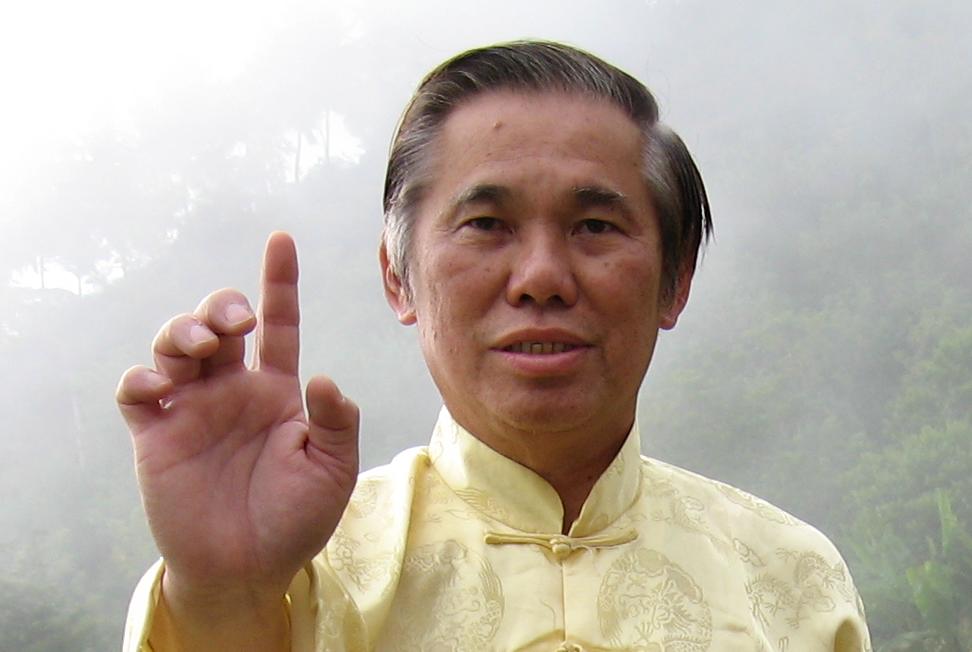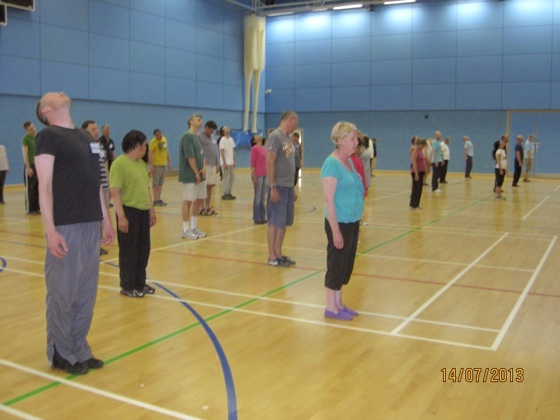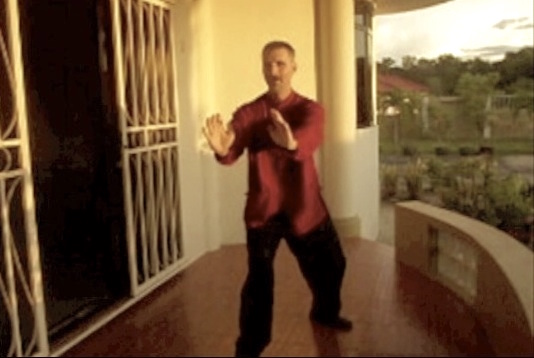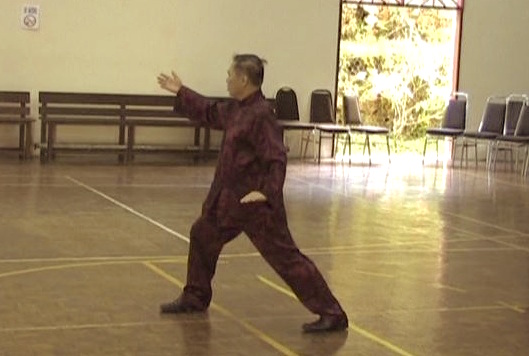SELECTION OF QUESTIONS AND ANSWERS
NOVEMBER 2014 PART 2

One-Finger Shooting Zen"
Question 1
My husband is worried that he is doing everything just right.
— Name and Country Withheld
Answer
The essence of chi kung is chi flow. At the bottom line, it doesn't matter what exercise a practitioner does, and how perfectly or otherwise he does it, as long as there is chi flow he is doing chi kung and not gentle exercise, and he obtains benefits.
At the next stage, presuming that the bottom stage is correct, the more perfect he does an exercise, the more benefit he gets from it. On the other hand, if he is too concerned, he may have adverse effects. Thus, the amount of benefit is an interplay of perfect performance and mental concerned to perform it perfectly.
To take an extreme example, if a practitioner performs low-level chi kung where the potential benefit is not great, and he is very concerned that he does it perfectly, he ends with adverse effects even when he actually does it perfectly because the harm from his mental concern over-rides the little benefit he gets from the exercise.
Ours is the other extreme. Our chi kung is of a very high level. Because it is high-level, the adverse effects from worrying are also higher than that of someone who practices a low-level chi kung even when he worries in a similar way, just like one engaged in a million-dollar business will experience a bigger loss than another engaged in a smaller business even when they make the same mistakes.
So in our case, the best approach is not to worry, including not worrying whether one is practicing correctly. This, of course, does not mean he purposely go against training instructions. Our benefits are so much that even when he does not perform perfectly and makes some mistakes due to carelessness or forgetfulness, the less than full benefits he gets are still much more than the full benefits other students get from practicing low-level chi kung.
And this is interesting. In fact we do not want our students, especially beginners, to practice perfectly. If they get full benefits, the benefits will be too powerful for them. They will over-train and drastic cleansing, which is uncomfortable, may result. So, just have fun in the practice, and let the benefits come quite naturally.
At the third stage, choosing the most suitable exercise will give better benefit. Our chi kung is so high-level that even when a practitioner chooses the lest suitable exercise, so long as he practices it as chi kung and not gentle exercise, and he does not worry, the benefit he gets is still more than the benefit most other students get.
The analogy of the million-dollar business is appropriate. Suppose the businessman has chosen the least suitable methods of production and marketing, and earns only 1% of his potential profit, which is $10,000 instead of $1,000,000. $10,000 is still more than what most people earn.
Question 2
Earlier you told us not to send chi to the heart and brain, but just now we practiced sending chi to the brain. Can we send chi to the brain? And what should one do if he has some heart problems?
— Marc, Switzerland
Answer
The main reason why I advise students against sending chi to the heart and brain is not that it is wrong to do so, but as a precaution against doing it wrongly. In other words it a practitioner can correctly send chi to his heart or brain, it is beneficial to him. But if he does it wrongly it can be very harmful.
Of course, doing any thing wrongly is harmful. But sending chi wrongly to the heart or the brain is particularly harmful as the heart and the brain are delicate organs. Sending chi wrongly to the hands or the legs, for example, is also harmful, but obviously not as harmful as sending chi wrongly to the heart or the brain.
Even when he can do so correctly, it is still not advisable to take the risk because there are other ways to send chi to the heart or the brain indirectly. He can, for example, send chi to his back and let chi naturally flow to his heart, or he can send chi to his head generally, and let chi naturally flow to his brain. If his heart or his brain needs chi urgently, it will naturally flow there from his back or his head. In fact, even when he does not think of his back or his head generally, chi will flow to his heart or his brain if these organs need chi urgently. It is a natural characteristic of chi to flow to where it is needed most.
Then, why did we practice sending chi to the brain just now in the Bone Marrow Cleansing course. It was because this was exactly what this course was about. In other words, the purpose of Bone Marrow Cleansing at the highest level, i.e. the bone marrow level, was to direct chi to the bone marrow, which in classical Chinese terms also referred to the brain.
Would it be dangerous? Yes, it would be very dangerous if students tried to do it on their own, or by learning from books. No, it would not be dangerous if practiced systematically and methodologically under the supervision of a master. If something went wrong, like if a student did it wrongly, I would know and be able to rectify the mistake.
So, can we send chi to the brain? Yes, if we know how to do so safely and have remedial exercise if we accidentally make a mistake, but no if we do not know how to do so safely and have no remedial exercise.
What should one do if he has some heart problem? In this specific context, he should send chi to his back. Chi will naturally flow to his heart to help overcome the problem.
In a general context, he should consult a skillful chi kung healer or chi kung master. He should not attempt to heal himself by learning from books or videos.

Bone-Marrow Cleansing
Question 3
When would you recommend a student to slow down or stop certain aspects or the complete practice for a certain time because of cleansing symptoms?
— Sifu Leonard Lackinger, Austria
Answer
A main reason why they over-train is that they innocently under-estimate the effectiveness and powerful results of our training methods.
Over-training is now a major problem amongst our students in our school, and it usually happens amongst dedicated students. Even when they follow our advice of not over-training, and they normally do as they are good students, they do not do so sufficiently. In other words, even when they do not train as much as they like, they still over-train.
Many people know that we are effective, but they do not realize how more effective we are. They may think that we are two or three times more effective, which is a lot. Some of our students may not realize, and those outside our schools simply do not believe, that we are more than ten times more effective.
Quantifying some examples will make this clearer. The figures are, of course, rough guide but they provide some good basis of comparision.
Students of other schools, if they are lucky to learn from genuine masters and they themselves practice correctly, will be lucky to develop internal force after six months of proper training. Most students never develop internal force regardless of how long they have trained.
As a comparison, it took me more than 17 years after I started learning kungfu before I had some internal force. For the first 15 years my training was mainly external, but my sifu, Uncle Righteousness, was an excellent fighter who had much internal force. His internal force was due to many, many years of dedicated training, and this was and is the norm for masters with internal force.
For the next two years, I trained Wizuquan, and my school was well known for internal force. There was no doubt that my sifu, Sifu Chee Kim Thong, and my seniors had a lot of internal force. Like Uncle Righteousness, they developed their internal force after many, many years of dedicated training. But unlike in Uncle Righteousness' school, in my Wuzuquan training every movement was geared towards developing internal force. Yet, after two years I did not have any internal force. The fault, of course, was not due to my teachers, but due to my ignorance in both my practice and my understanding of kungfu philosophy.
When I learned from Sifu Ho Fatt Nam, by practicing One-Finger Shooting Zen daily for six months I had enough internal force to break a brick. The internal force was not just due to my One-Finger Shooting Zen training, but also due to my earlier training under Uncle Righteousness and Sifu Chee Kim Thong as well as my two years of Iron Palm training on my own. The six-month training of One-Finger Shooting Zen activated my dormant internal force. And I am sure I was an above-average student.
Hence, presuming other students take six months to develop internal force is reasonable for comparison. How long do our students in Shaolin Wahnam Institute take to develop a similar amount of internal force? Six days! In fact, those who attended my Intensive Shaolin Kungfu Course or Intensive Taijiquan Course, could develop internal force on the very first day! It is true that these course participants had prior kungfu experience, generally about a few years. But don't forget that I had 17 years of kungfu experience under two of the best kungfu masters in the world, yet I took six months to have some internal force.
If our students take 6 days to develop internal force, and other students take 6 months, it means that our method is 30 times more effective. If we translate internal force to cash flow so that we can have a better idea in daily life, this means that if other students earn 5000 euros a month, which is more than what many people earn in Europe, our students earn 150,000 euros.
Hence, even when our students reduce their training to 10%, they are still 3 times more powerful than other students who succeed in developing internal force. In other words, instead of getting 150,000 units of internal force, they now get only 15,000 units, but this is still 3 times more than what other students get for 5000 units.
The reduction of productivity from 100% to 10% can be through time or intensity, or both. Instead of training for 60 minutes, he can train for just 6 minutes, or instead of training in a very deep state of mind he can train in a less deep state of mind.
Let us presume, for the sake of comparison, that 5000 units of internal force is manageable. In other words, if a student develops 5000 units of internal force -- in 6 days or in 6 months -- he is fine. But if he pushes himself and trains 5 times as hard, and obtains 25,000 units of internal force, he reaches his optimum point. If he pushes himself further, he over-trains, and over-cleaning or adverse effects may result.
We do not know where exactly is our optimum point. It varies according to different persons, as well as different times for the same person. One has to estimate his optimum point from direct experience.
But if he trains at 10% of his potential, he probably under-trains, but he is save. For our students, they get 15,000 units of internal force when their optimum point, let us presume, is 25,000 units. If he trains at 50%, which is only half his potential, he probably over-trains; he obtains 75,000 units of internal force when his optimum point is 25,000 units.
Except for our instructors and senior students, most participants in my courses over-train. As I have often mentioned, my courses are good examples of bad practice but excellent learning. Course participants learn in a few days what they need many months to practice on their own. I have also mentioned that if course participants find their results at home only a quarter of what they experienced at the course, it is perfectly fine. If their results at home are similar to what they experienced at the courses, it is likely that in time they will over-train.
The optimum point increases as one progresses. Initially the optimum point for a student may be 25,000 units of internal force. After a few years, it may increase to 250,000. This means he is 10 times more capable than before.
The above philosophy provides the basis on which you can give advice to your students depending on their situations. Over-cleansing is a result of over-training. Over-cleansing is actually beneficial but uncomfortable. It speeds up recovery too fast.
If over-training continues, adverse effects take over. Adverse effects are both harmful and uncomfortable. It is not easy to know when over-cleansing ceases and adverse effects start. Theoretically it occurs at the time when benefit becomes harm.
When cleansing is comfortable and manageable, a practitioner should continue as he has been doing. When over-cleansing occurs, i.e. when cleansing has become uncomfortable, the practitioner should slow doen -- in time or in intensity of practice. When adverse effects occur, he should stop training until the adverse effects subside. Then he resumes training gradually.
These are philosophical principles. How skilful a teacher is, depends much on his judgment basing on these principles.
Many people think that every teacher is the same. They also think that every art is the same. These are big mistakes, which not only result in these people not getting the benefits from the arts they practice, but worse they derive harmful side effects.
Question 4
Chris already gained great benefits in his first few weeks of Chi Kung. Because of an accident he could not spread his thumb away for years. In Chi Flow he felt some kind of flash in his thumb and since then he can fully move it again.
Now since he entered my Tai Chi Chuan class he practices Zhan Zhuang diligently. Soon his legs started to tremble by the internal force generated, sometimes even when he was lying in bed. I told him it was chi cleansing some blockages in his legs and that he can slow down the stance training if it gets too uncomfortable to reduce the amount of internal force.
He slowed down his whole practice bit by bit. Now, as soon as he takes up Wu Ji stance and relaxes his legs still start shaking.
I am sure it is not from muscular tension and I know it does him well. I also told him that he can think of his feet to drain some of the excessive energy in case it gets too heavy. He doesn't need to do so, because it is not uncomfortable, but understandably it is disturbing his focus while practicing and he sometimes takes a break during class.
Answer
The concept of vertical shift and horizontal shift is useful for Chris.
He can adopt a vertical shift by developing skills to enable him to be focused despite his trembling legs. We have many techniques to achieve these skills, like focusing on certain features of combat when practicing combat sequences, or focusing on making his girlfriend happy when taking her out.
Or he can adopt a horizontal shift like taking a break during class.

Sifu Charles Chalmers performing Wuzuquan
Question 5
It is interesting that his girlfriend who recently fell on her knee while riding her motorcycle experiences the same symptoms now. She is a good student and did Lifting the Sky directly after the accident, much to the bewilderment of her observing bikers club friends. She joined the Tai Chi Chuan class two days after the accident despite her doctor telling her she won't be able to bend the knee for at least two weeks.
Hers is a clear case of chi cleansing the blockage from her swollen knee, but Chris' trembling in the legs happens for no obvious acute reason and for about 2 months already.
Answer
There is a good reason for Chris' trembling legs though he and many other people may not realize it. Chi is breaking through his deep blockage caused long ago, may be in his past lives. When the blockage is cleared, indicated by ceasing of his trembling legs, he will find himself a new person.
Question 6
As you know, my dear student Evelyn has been going through heavy periods of cleansing. She made great progress, but still has quite some emotional cleansing issues. I'm sure they will cease when she is through and somehow she is already used to the strange things happening, so I am not worried. She also gained a lot of confidence by teaching a few classes during my holidays, which she did very well.
I am very glad that she will be attending your very special Art of Teaching course and thank you very much for accepting her. My days of vacation are already spent this year, so it's great to have her there.
Answer
Evelyn has a lot of emotional blockage caused in her childhood or past lives. We need not have to know when or how the blockage was caused. We know that when the blockage is cleared, and it will be soon, she will be a happier and healthier person. It was a great blessing for her to learn from you.
Grandmaster Wong performing Wudang Taijiquan
Question 7
Now, I did something which I though would never happen. I recommended her NOT to join the Wudang Tai Chi Chuan course. I let her to decide, but told her my opinion which eventually turned out to be most influencing her decision.
Normally I would always recommend any of my students to join any of your courses, but I didn't have a good feeling about her joining the course this time. Of course she would be perfectly prepared in time and would gain a lot of skills, knowledge and experience.
But when she came home after the UK Summer Camp and also after the Shaolin Mountain Retreat of Kai Siheng, she was so overloaded that her cleansing went far beyond the comfort line and even influenced her normal day living.
While it is unbelievably wonderful that Evelyn had the chance to practice 5 kinds of martial arts during this year, she should also take time to process, review and train everything she learnt. This influenced my decision, because the Wudang set is very extensive and needs a lot of care.
Answer
What she will learn at the Art of Teaching Course will be very beneficial to your classes.
You have made a right and good decision for Evelyn regarding the Wudang Tai Chi Chuan Course. If she asks me I would have given the same advice.
Although Wudang Taijiquan is a great course, Evelyn has taken a lot of other great courses. It is better for her to skip Wudang Taijiquan and focus on what she has learned.
The benefit from spread and depth is from both spread and depth. Even leaving aside considerations for her cleansing, Evelyn has a lot of spread. Now she can focus on depth.
Question 8
I know that cleansing is not always fun and often it's better to "train and push trough", but in my opinion people should still be able to mange their day comfortably without emotional outbreaks and trembling legs in normal day living.
Answer
If the cleansing or over-cleansing is manageable despite some discomfort, it is better to train and push through. If it is uncomfortable, despite its ultimate benefit, it is better to slow down or even stop completely for some time.
An exception will be a life-death situation, in which case and when the healer is certain, the patient must push through and live, rather than die though less painfully.
However, nothing is absolute. There is an exception to the exception. If breaking through is terribly painful for a dying person, and even if he survives, his quality of life is not high, it may be better for him to leave the world peacefully and painlessly so that he may be reborn at a better place.
Whether one is a teacher, a doctor, a healer or a priest, the art of judgment is often more important than the science of facts.
LINKS
Selected Reading
- Cyclic Progresses of Cleansing, Building and Nourishing
- About Sifu's Teaching
- Shaolin-Taijiquan against Jujitsu Wrist Lock
- It's Drunken Eight Immortals, Not Aikido
- Taming-Tiger Combination Set 2014
